Transdisciplinary Art-Based Collaboration
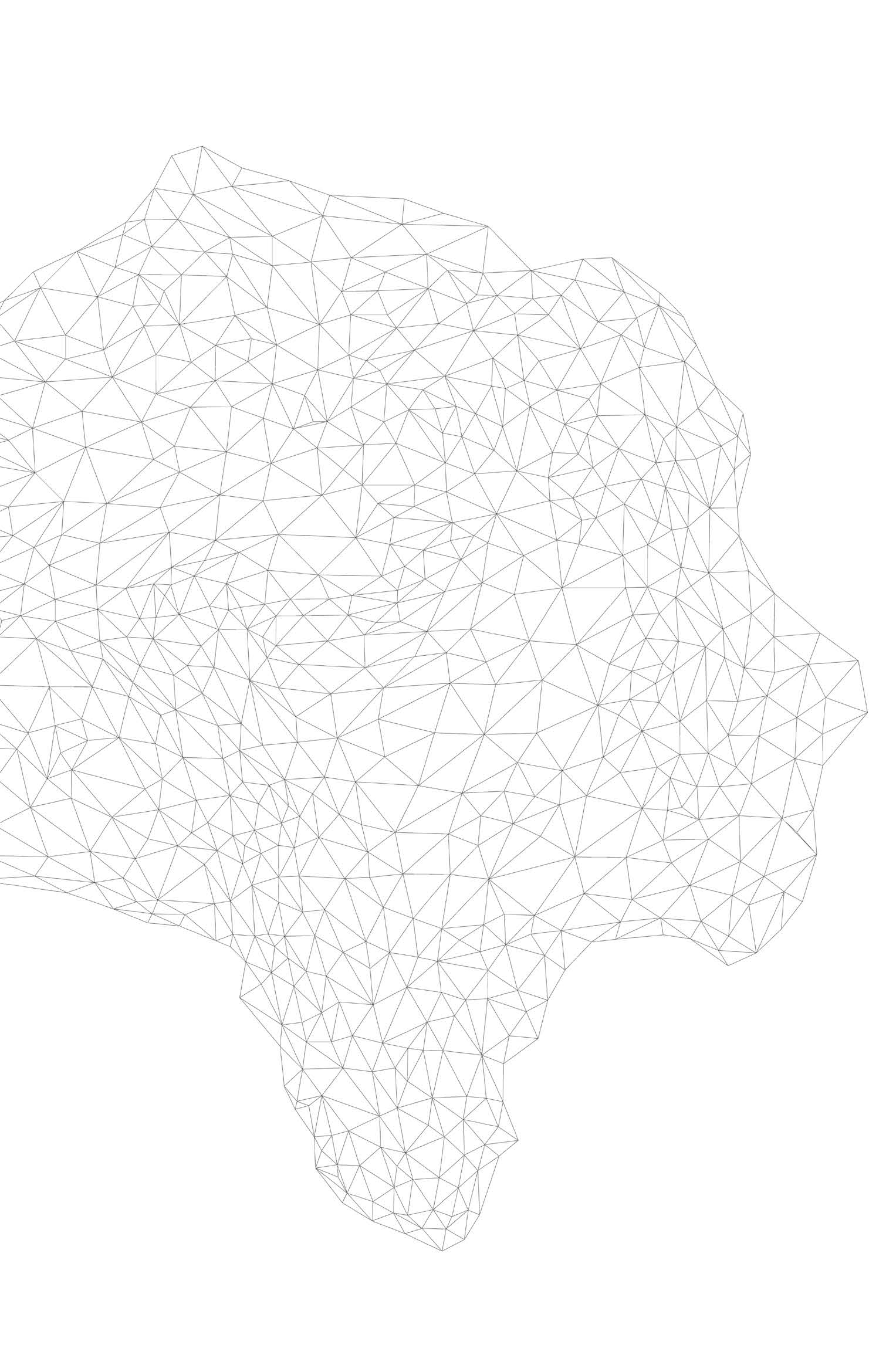
Lucas Maddock, “New Hypothetical Continents” (Detail, 2014), point map (artist’s work)
Project initiators and key authors:
- Dr Benjamin Matthews (Western Sydney University)
- Lucas Maddock
1. Project Description
1.1. Introduction
Over recent years, there has been a resurgent interest in utopia in the arts. Indeed, Vermeulen and van den Akker (2015) have described what they see as a “utopian turn” in contemporary art, where a “structure of feeling” that moves beyond the postmodern has emerged. Certainly, understanding the influence of utopia becomes increasingly important in the kinetic digital age where speed and surface play replace depth and reflection. Even websites, once examples of databased content to be explored over time, have been disrupted by the “feed” format of social media, where the most recent demands attention and our concentration is shifted ever forward into an urgent “data present” (Manovich).
The speed of this data flow relates strongly to Paul Virilio’s (1999) increasingly relevant dystopian vision of the loss of the “body proper in favour of the spectral body” (48). In Virilio’s view the body, suspended in digital space, slips away from the world tapping frightening potentials to generate fictive utopias as hypothetical versions of reality. He would later name this space the “sixth continent” and claim that it threatens the “morphological stability of reality” (Politics, 86). These alternative realities exist as bodies or fictive masses in their own right – divorced from reality we refer to them here as “hypothetical continents”. With particular interest in how utopian accounts threaten to dominate the non-space of this sixth continent, NHCs frames a challenge: how are we to resist the dystopian impetus of the sixth continent? Is it possible the media on which this emergent hypothetical continent is based can push back toward the world, and stabilise our accelerated sense of the real?
Some hope for an answer in the affirmative can be discovered in the argument that the sixth continent is also inhabited by the kinetic agents of resistant, radical groups that include creative content makers of all kinds: artists, filmmakers, photographers, anthropologists, philosophers, writers, curators, coders and musicians. Networked individuals and collectivism is able to formulate alternate places that supplement the most visible territories of the sixth continent.
Through the facilitation of informal networks of collaborators and the establishment of an interactive website, NHCs will host and amass a burgeoning database of creative materials that will aim to both disrupt and, paradoxically, stabilise the bodies that intersect and become tangible via these hypothetical spaces.
This collective and the repository of works it establishes will foster the intent to disrupt the line between database and world. Interactants will participate in the generation of opportunities for dialogue, producing works that irrupt from the digital and connect body with world via a range of forms of mediation. In this way, the database becomes a commons and an anchor to the collective’s intent to disrupt the spectral body by creating new fixing points beyond the digital.
The first step will be to establish an interactive website as a platform for a new hypothetical territory – one that creates a stable virtual “space”. Here, collective reflection and exploration are possible, encouraging broad and dynamic participation such that new hypothetical continents can be presented, and existing ones may be critiqued and responded to.
This will be achieved by inviting viewers and participants to pause, reflect, and engage with apparent contradictions between utopian intent and outcome in both contemporary and historical instances. Interactants will browse through a collection of previously uploaded user-generated content, and become participants in a community of value by commenting on and responding directly to the work of other members.
In this way the NHCs database will present and facilitate the generation of materials that will identify scenes of origin and myth generation, and use these as the basis for reality driven representations and performances of history. It will establish the database as a stronghold: a database to anchor against the destabilising speed of the data stream, and the data present while sparking dialogue, discussion and creative responses to the continuing influence of the figure of utopia.
The central, and necessary, element of the project for 2017 will be an interactive website that contains contextualising documentary-style semi-narrative content, along with a participatory interface. The audience will be invited to contribute examples of objects and reflective writing that explores the NHC’s theme of utopian portrayals of history. These may be either found (and recontextualised) art works, or items created as a response to the project’s theme.
1.2. Material Outcomes
Examples of material outcomes may include: interactive web-delivered creation/s; events such as curated exhibitions and performances that incorporate multiple media and players; and Creative Commons licenced digital and print publications. For instance:
- Exhibitions (online or otherwise) of items curated from contributions to the website and composed by participants
- Multi-disciplinary book (electronic and print versions)
- Dramatic performance including live electronic/traditional musical interpretation/performance
- Free standing curatorial projects
1.3. New Hypothetical Continents?
The 2010s have given rise to collective aesthetic and intellectual movements that engage with the impact of global flows of digitised capital and culture, and the expanded influence of related industry such as high-tech manufacturing. Examples include “Vaporwave” (music), “the New Aesthetic” (design) and “ruin porn”, each of which are only made coherent by presenting consistently ambivalent responses to the effects of technology, and very frequently these responses rely on high-tech means of creation and mediation. Each movement is emergent, in the sense that they are not intended or centrally governed, but instead are spontaneous creations of extended networks of individuals. The participants tend to respond to a broad set of themes and conditions via aesthetic means, rather than the particular circumstances and politic that tended to define the art movements of the 1900s.
These movements express dissatisfaction with the utopian presentation of technology and its impacts by the agents of late capitalism that dominated the period leading up to the end of the second millennium. Digital communication and media, high-tech manufacturing and the computational devices and processes they rely on are the subject of direct or indirect comment. Typically this is achieved by removing and reframing the output from the circumstances of its production, in the mode of appropriation that underpinned the art movements of modernism. Here, these aestheticising procedures are executed with goal of participation in a self-corrupting joke: one intended to fail at all but the expression of ambivalence.
If the “new” quality in these contemporary aesthetic engagements with history is to be distilled, then, it must be as a frustration with the utopian presentation of the role technology was to play in our lives. Intentionally paradoxical, the participants express a distaste for the very process of appropriation that underpins the movements in the first instance – and a sense that beyond the remix culture that they comment upon is an empty nostalgia that leads only toward the allure of utopia itself. This is why each movement engages with themes such as control and surveillance, corruption, decline, decay and ruin via high tech means that hypothesise dystopic visions of impossible present day coherence. There is no such thing as the New Aesthetic or Vaporwave: they are dark comedy instead, parodic of coherency, and perhaps better understood as representing a sensibility rather than movements.
Whilst attempting to understand this sensibility, it is useful to look across the history of utopia. Utopia has been variously defined as preoccupied with a past that never was, a future yet to be realised or a forcibly imagined present in the mode of fiction. The last became orthodox in early modern utopias, where fictional islands became the site of seminal works that are now considered precursors to the modern novel. Strong examples are works such as Sir Thomas More’s Utopia (1516), Francis Bacon’s New Atlantis (1627), and Henry Neville’s The Isle of Pines (1668), which became effective critiques of dominant ideology by offering fictive solutions to social contradictions of that time[1].
Each of these fictions hypothesise a space, and present narrative portrayals of elements of the real world in a new, “ideal” configuration “as-if” they were real. This rhetorical as-if gesture contrasts the virtual dimension of the utopia with the reality outside these imagined spaces, inviting reflection on each. For instance, the full title of More’s fictive work of political philosophy was De optimo rei publicae deque nova insula Utopia[2]. His defining name for the island society herein described – Utopia – combines the Greek prefix “ou-” (οὐ), meaning “not”, and topos (τόπος), meaning “place”. This (very likely) satiric construct describes a model society founded on slave labour in a non-place, or a place that does not exist.
More’s ideal construct was likely intended as a comment on the dangerous quality of assuming ideal situations are ever able to exist. However, given their proximity with the world beyond the fictional construct, utopian narratives are ever in danger of collapsing into the real, and being mistaken for reality itself. They rely on reflection, and time taken to contrast the as-if with that which lies beyond it. In recent history and the present, speed of information flows and mobile access mean permanent connection to large volumes of data in real time for many – and that the remainder of us are entangled with the effects of this connectivity.
Lev Manovich (2013) argues that rather than engaging with databases, as we once did via the World Wide Web, we now live in the “data present”, as is evident in ubiquitous construct of social media, where feeds create a continuous flow of events he calls the “data stream”. Each event will work to “push the earlier ones from the immediate view. The most important event is always the one that is about to appear next because it heightens the experience of the ‘data present’”. The data stream participates what Manovich calls “a quintessential modern experience (‘Make it new’), only intensified and accelerated”. The new, in our present world, replaces reflection with speed, such that any challenge or resistance created by utopian fictions is overwhelmed by immediacy and volume.
In Paul Virilio’s description of the “sixth continent” he argues that the body becomes lost, creating a:
confusion in feelings of belonging and with the drift of the five continents that make up geographical space towards the sixth continent of cyberspace, [such that] suddenly the morphological stability of reality is threatened with collapse. If it goes down, it will not only drag culture down with it, but also – equally – the most durable reality there is: the reality of the orientation, not of some ‘hypnotic’ vision now as in the past, but of the very fact of being-in-the-world and the rationality that goes with it. (University, 86)
His terrestrial creation, the sixth continent, inhabits a virtual space, but with the effect of destabilising the relationship between presence and rationality. This pattern, Virilio insists, is consistent with a history where the powerful shape narrative representations of the present.
In “cyberspace”, such fictions of the present operate with sudden potency, and as a result, the usual pattern of conquest and control is being repeated. Virilio argues this “hypnotic vision” is elevated to the position of reality, replacing the existing geographic construct, and writes of the recent “neocolonial conquest of this ‘sixth continent’, of a virtual space that replaces the real space of the other five [continents]” (Stop, 77). For Virilio, reality itself is at stake, where the contest over being challenges the ontological stability of more than individual and collective perspective on history: into the bargain, a collapse of rationality threatens to remove any and all sense of being-in-the-world.
2. Initial Experimentation on the NHCs
2.1. Utopia and Glover’s Hobart – Dr Benjamin Matthews and Lucas Maddock
Mount Wellington and Hobart Town from Kangaroo Point, by John Glover (see Figure 1) was created at a time when most Tasmanian Aborigines had died as a result of the Tasmanian Black War with the remainders incarcerated on Flinder’s Island. Yet in the foreground of the work can be seen a group of subjects portrayed as free to act and inhabit the landscape with a “native”, undisturbed presence.
In this example of a utopian vision we see an origin point fixed for a fictional history – regardless of Glover’s intent, this origin is an invented scene that enables and generates false perspectives on history.
The real Tasmania, or Van Diemen’s Land, was founded as a penal colony in a manner disturbingly similar to the originary fictive vision created by More in his Utopia. In Tasmania the use of convict labour replaced the slaves, and the fictive premise of Terra Nullius permitted a rationale for the removal of native inhabitants. Assuming the status of Terra Nullius, from the Roman law that dictates this is “nobody’s land”, on behalf of Tasmania meant assuming its “discovery” rendered it a reality. In other words, from the European perspective before this time Tasmania was a “not” place. A non-place: a Utopia discovered, and simultaneously created.
This fictive dimension appears extended in the portrayal of the natural environment in Glover’s painting, which is exaggerated to present a romantic vision and mode of dissociation from (and reduction of) reality that appear intrinsic to the colonial endeavour and its justifications.
The handling of the indigenous subjects in the foreground is consistent with this utopian aesthetic presentation, which relies on the creation of an artificial binary of inclusion and exclusion. In order for a utopian project to progress, its subjects must firstly identify with their goals and act accordingly. This necessitates the identification and exclusion of those who are not working toward the common goals, and the creation of the “other”. The end point in such a divide is often justified exploitation, displacement, prejudice and as starkly exemplified by the history of Tasmanian colonisation, persecution and genocide. This is one of the elements of colonisation that appears common to utopian endeavour: its tendency to create “collateral damage”.
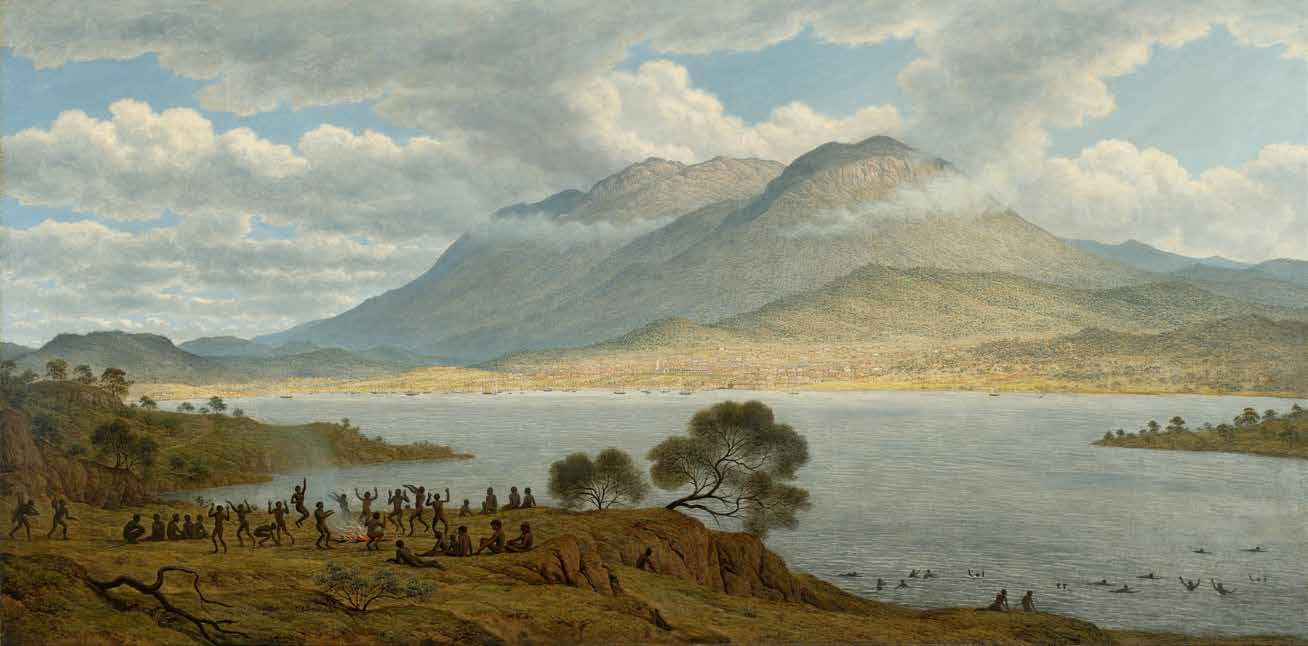
Figure 1: John Glover, “Mount Wellington and Hobart Town from Kangaroo Point (1831-33),” (1834), oil on canvas, 76.2 h x 152.4 w cm framed (overall) 995 h x 1750 w x 115 d mm, National Gallery of Australia (public domain).
Glover’s painting depicts the fundamental structures of two opposing civilisations, one illuminated, the other shaded, playing out the violent theatre of survival on an awe inspiring stage. The majesty of Glover’s natural environment participates in the myth of rule by nature over civilisation, and the prevailing “reality” of the need to respond with artificial means of control. In the background, “Red Coats” can be seen drilling and toiling in semi-orderly lines on the hillside near Hobart, as the mountains rear-up to powerful heights behind.
Glover’s depiction of these people (in the foreground) creates a beguiling narrative. The painting depicts and denotes a happy co-existence between civilisations, but what does it connote? This ambivalent scene could be propaganda that masks the atrocities of the colonial power, or contrapuntally, sarcastic and satirical injunction. The dynamic created by this ambivalence points toward a problematic assemblage; one which is further polarised by the illumination of Hobart Town by the sun in an otherwise shaded sweep of water and land.
A thick reading of the apparent exaggerations of the environment might lead us to assert a connection between the artist’s enthusiasm in this ostensibly innocent distortion of reality (that has resulted in so romanticised a depiction), and a far more sinister reality that will result in (and even permit) atrocity.
2.2. Experiment #1_ New Hypothetical Continents (2014) – Lucas Maddock
In 1969 artist Robert Smithson appropriated an illustrated map from Lewis Spence’s History of Atlantis and used it to form the basis for his installation Map of Broken Glass (Atlantis) (See Figures 2 + 3). Smithson’s installation came in the wake of his failed Island of Broken Glass project, which would have seen several tonnes of broken glass piled on an Islet in the Georgia Straight. When viewed from afar, and in direct sunlight, the installation was intended to affect a “shimmering collapse of decreased sharpness”.
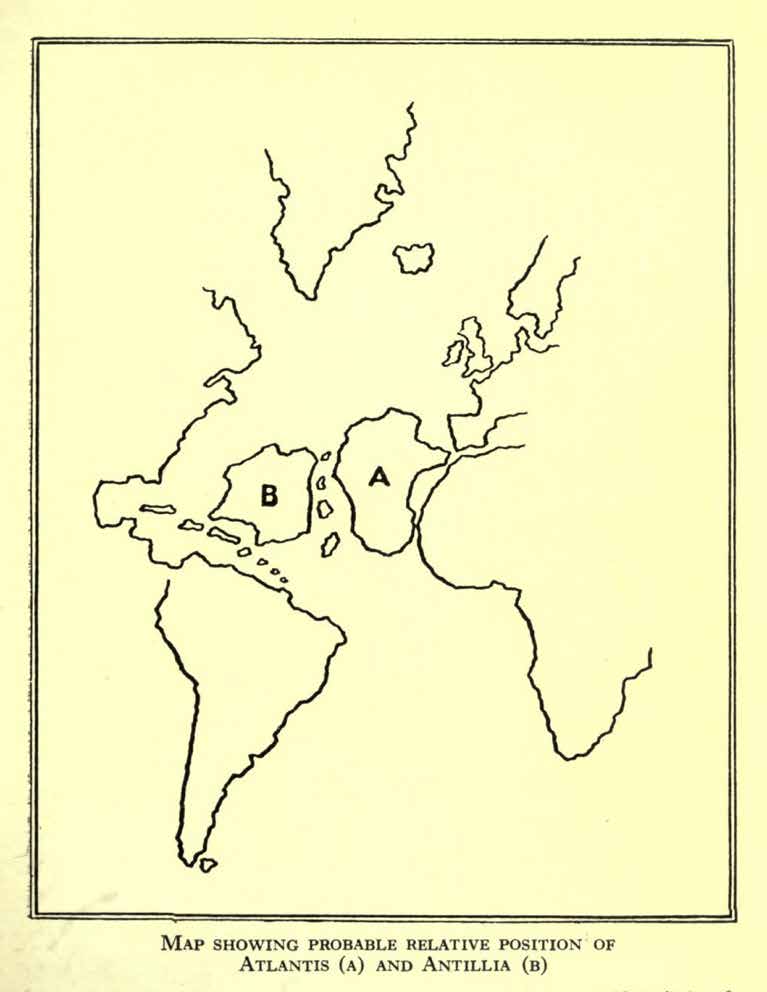
FIgure 2: Lewis Spence (1874-1955) “Map showing probable relative position of Atlantis (A) and Antillia (B)” as published in The History of Atlantis (1926).
In this light, the Map of Broken Glass (Atlantis) appears consolatory and captures all the pathos of the ‘unrealised project’. The Lewis map presented here, once again in sculptural form, draws inspiration from our fascination with the spectacular and the romantic and dissociated wonder prevalent in John Glover’s Mount Wellington and Hobart Town from Kangaroo Point (1831-33). Exploring how dangerous utopian notions permeate our current ideologies, NHCs presents a contemporary Atlantis – one standing at the height of its glory and boasting a spectacle so great that it can only warn of its own demise (see Figures 4-8).
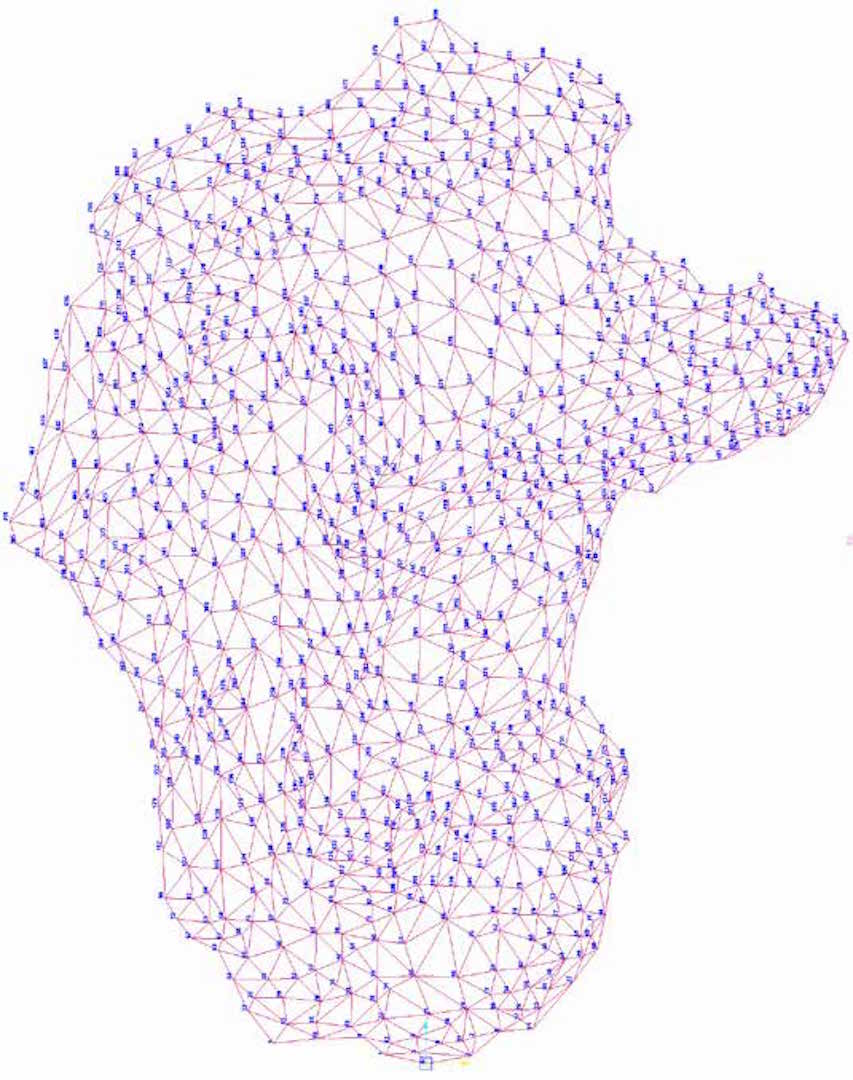
Figure 4: Lucas Maddock, “New Hypothetical Continents” (2014), point map (artist’s work)
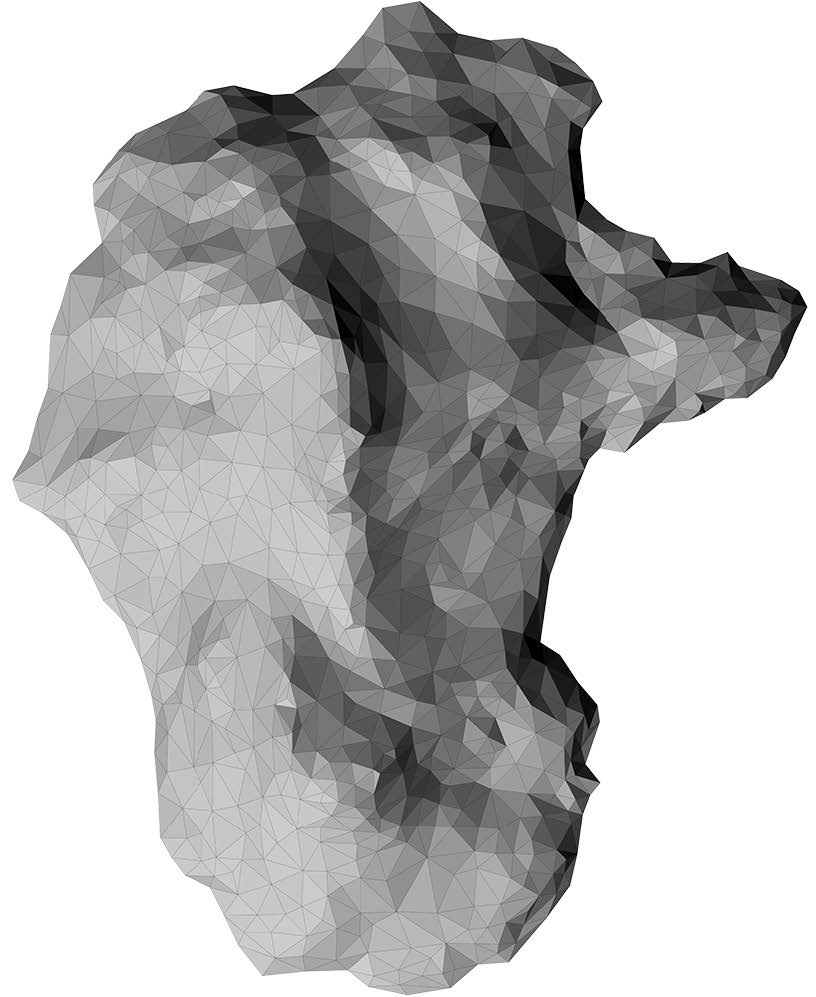
Figure 5: Lucas Maddock, “New Hypothetical Continents” (2014), computer generated model (artist’s work)
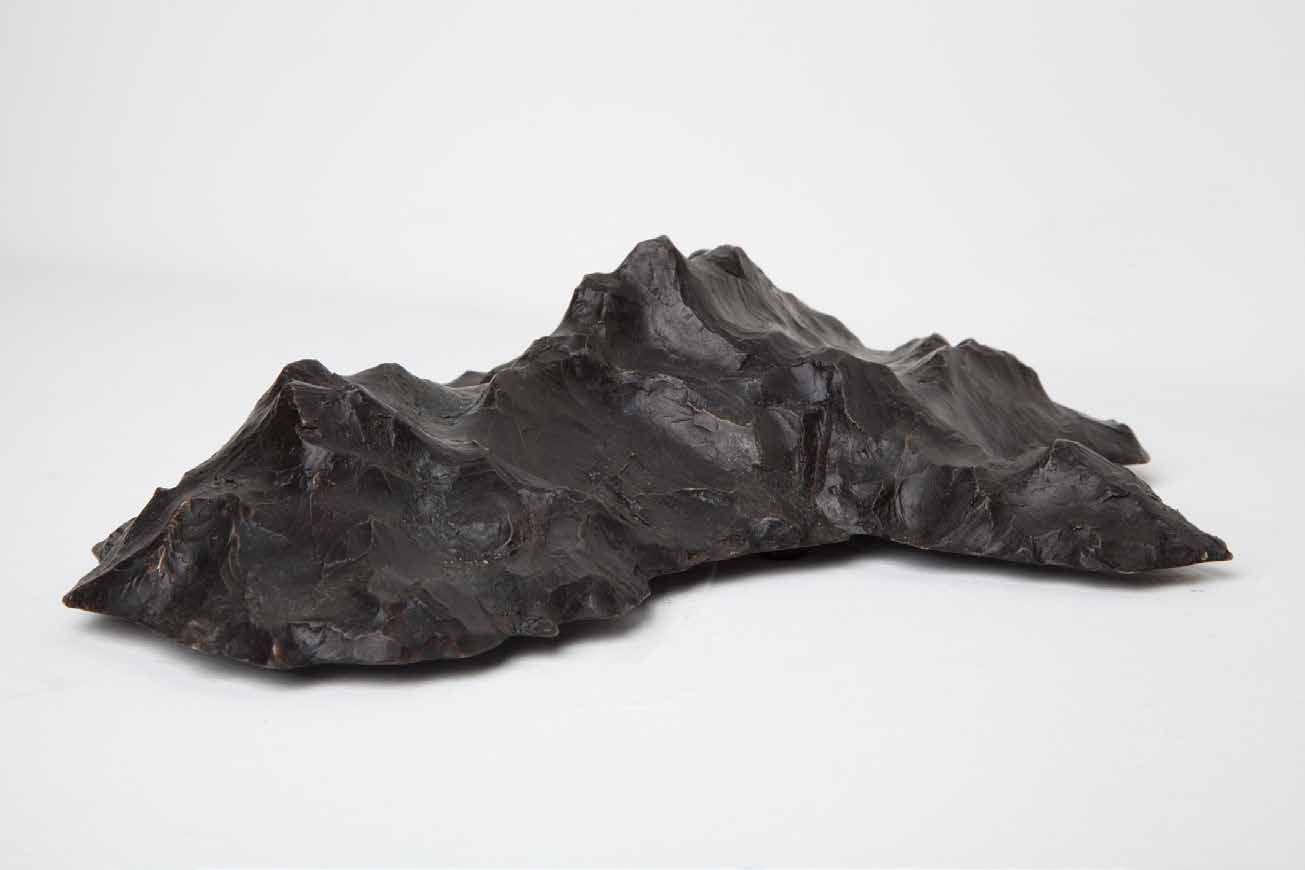
Figure 6: Lucas Maddock, “New Hypothetical Continents” (2014), maquette, bronze, edition of 5 + 1AP 26 x 20.5 x 8 cm (photography by Christo Crocker).
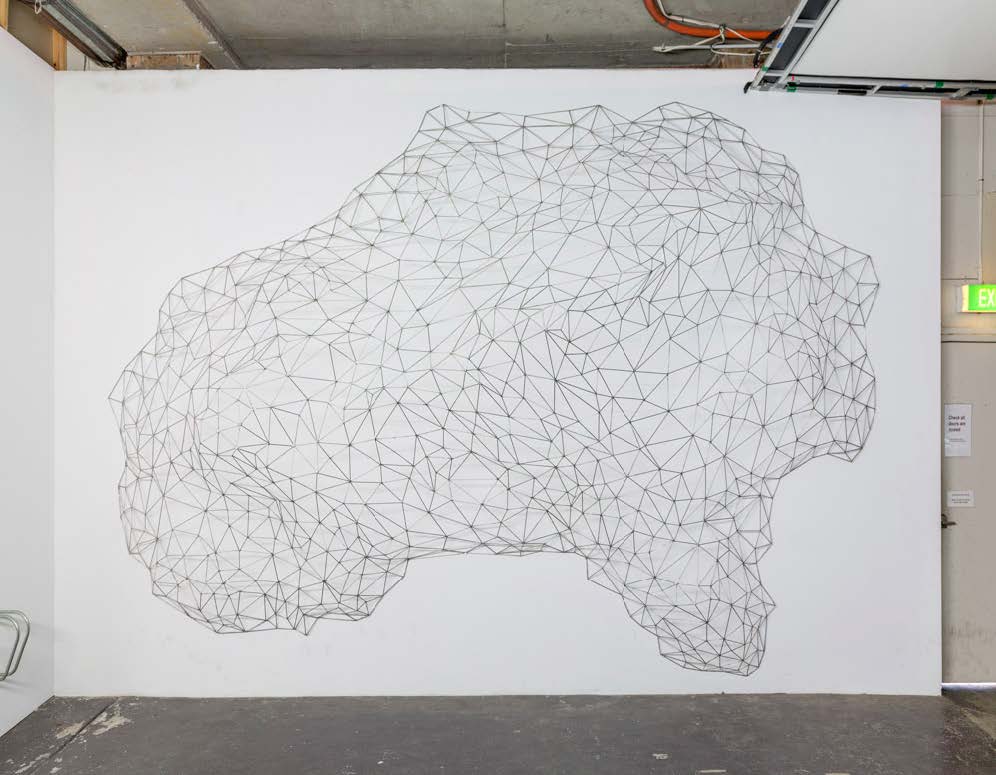
Figure 7: Lucas Maddock, “New Hypothetical Continents” (2014), wireframe, 460 x 350 cm (photography by Christo Crocker)
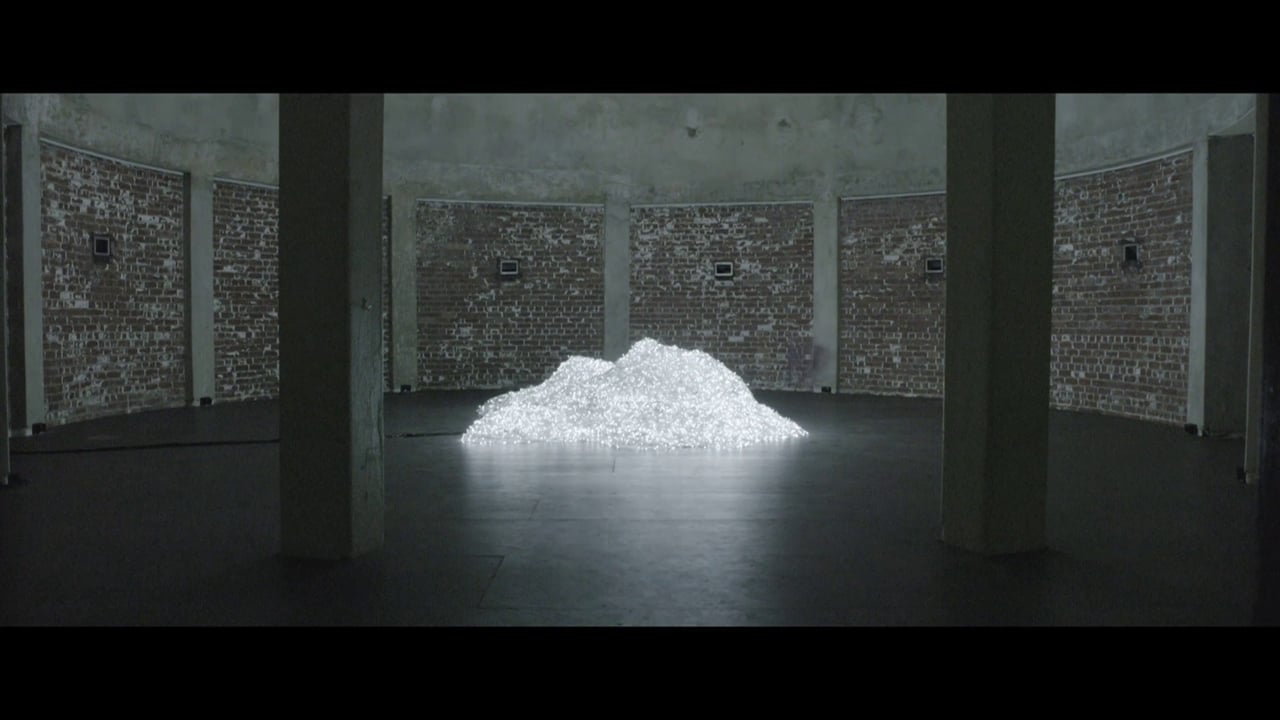
Figure 8:Lucas Maddock and Darius Devas, “New Hypothetical Continents – Norla Dome Film” (2014), still, (artist’s work).
2.3. Experiment #2_ Neokairos: The NHCs as an Algorithm – Dr Benjamin Matthews (2014)
Formulated as an algorithm, these conditions and potentials can be imagined as constituted by the following:
- The difference engine that is formed when utopia is placed alongside dystopia is frightening in its scope but appropriately braced by the vertiginous potential in human communities for rapid change. Equally confronting in memory is the inevitable juxtaposition of these categories.
- Like any binary opposition, this one is built on transcendence, and in our attempts to capture these orbiting suns we are reminded that they are fictive categories, and absent definition: that this possibility is deferred at the event horizon of our capacious imaginal function.
- Imagine a digital portrayal of this event horizon as a non-space. In so doing one has a sense of the depth of the network, the condition of contemporaneity, or atemporaneity: the sixth continent that is emergent from this atemporaneity, generated in cyberspace and based upon informational technologies, inhabits no space at all.
- How can the centre hold in this apophatic space? Where the dialectics of inclusion and exclusion, inside and out, have collapsed with a paradoxical flatness – paradoxical, since this is a vertical emergence – the nonterrain does not anticipate a future, or have memory of a past.
- The scene of culture is here challenged, replaced by kairos, or an ongoing presentness. This is the scene of culture, this real-time in which the individual is freed of the constraints of temporality and spatiality, but made to lie about their presence by virtue of these facts.
- Where the ecological circumstances of the network – it has only emerged on this scale and in this way because there is no “future” in the real human habitat – remind us too, in real-time, of the speed at which the non-future approaches.
- Thus, we, the networked individuals, are spurred on to greater action, a great sense that this is the time. We are of a false sense of kairos, a “neokairos”, and so we photograph every moment and stencil it as data across this site of exchange, where sacrality has become diluted by the absence of a centre, and the inability of any single scene to capture the attention of the community.
- Into this space erupts a new aesthetic, the aporetic non-solution to the loss of ground on which to set the moral compass, and bound the moral sense. In the network, under the conditions of now, those who know are the heroes. Those who know notice that there is a centre, something is still sacred, that there are still victims, and they remember what abstraction is.
- And so we see emerging in the network itself the paradoxical agency associated of this new aesthetic, realised as presence of memory, of staged and restaged scenes of culture on which the future is indicated, and on which we are reminded of the presence of individual and collective memory.
- Via the ocularcentric network is re-presented an alterity of the image: the flat death of two dimensionality generated by pictures is rendered, rethought, re-shifted to remind us of its consumption by us, of how this abstraction becomes the imaginal condition of the 3D human agent being-in-the-world.
- Abstraction itself may have already been host to a singularity after which this flatness became the habitat for a discourse that is beyond us, and in the world of objects, where an alien intelligence may exist, and where possible bodies huddle.
- But you, meanwhile, as object, are corporeal and mobile. You share this sensibility as you continue to hack, to contribute to the flat world of data, and as it (the sensibility) directs you to remember that you are not a tourist.
- Instead, you are an irenic agent, obsessed to map memory against photographic record of your passing (through natural and plastic environments), having laid aside armed and threatening violent intrusion in favour of the mediative shoot.
- Not soldier, nor auteur, you are instead, the finally global-object-citizen, free to explore and create in simultaneity new hypothetical continents that may stabilise not only your vision, but your being, in an action that recuperates reality itself.
3. Works Cited
Manovich, Lev. “Future Fictions.” Frieze, 16 June 2013, https://frieze.com/article/future-fictions. Accessed 16 Nov. 2016.
More, Thomas, Bacon, Francis, and Neville, Henry. Oxford World’s Classics : Three Early Modern Utopias : Thomas More: Utopia / Francis Bacon: New Atlantis / Henry Neville: The Isle of Pines. Cambridge, GB: Oxford Paperbacks, 1999.
Vermeulen, Timotheus, and Robin van den Akker. “Utopia, Sort of: A Case Study in Metamodernism.” Studia Neophilologica, vol. 87, no. sup1, Dec. 2014, pp. 55–67, 10.1080/00393274.2014.981964.
Virilio, Paul. The futurism of the instant: Stop-eject. Polity, 2010.
—-. University of disaster. Polity, 2010.
Virilio, Paul, et al. Politics of the Very Worst: An Interview by Philippe Petit. New York, Semiotext (E), 1 May 1999.
[1]See More et al. for a detailed discussion (pp. ix-xlii)
[2]Ibid.




